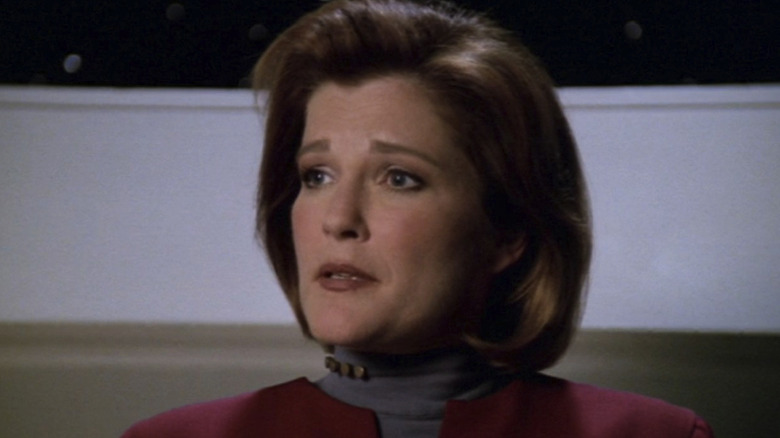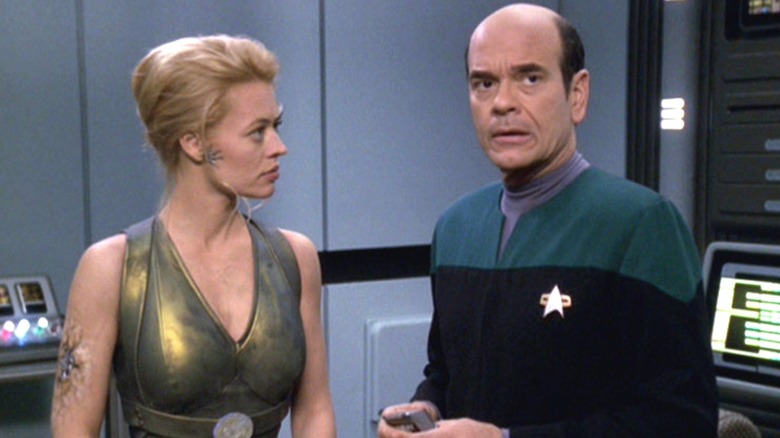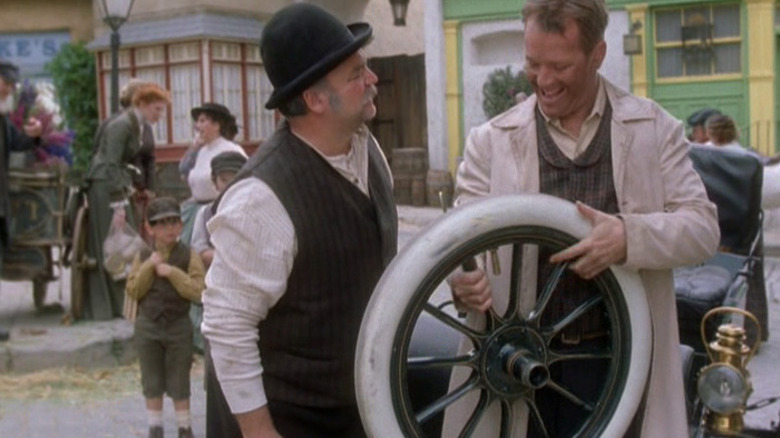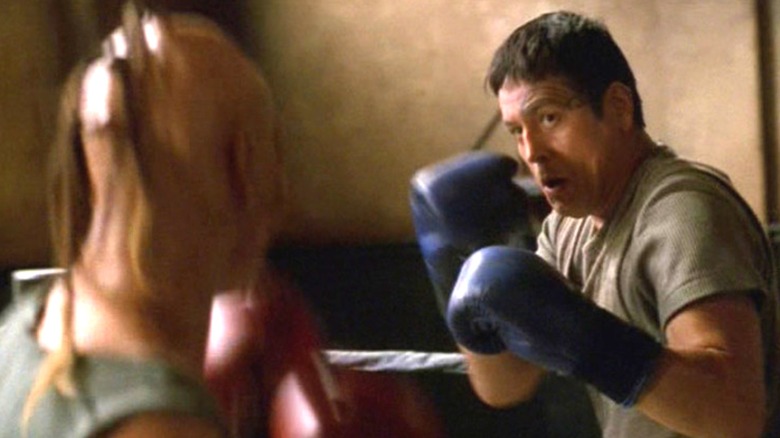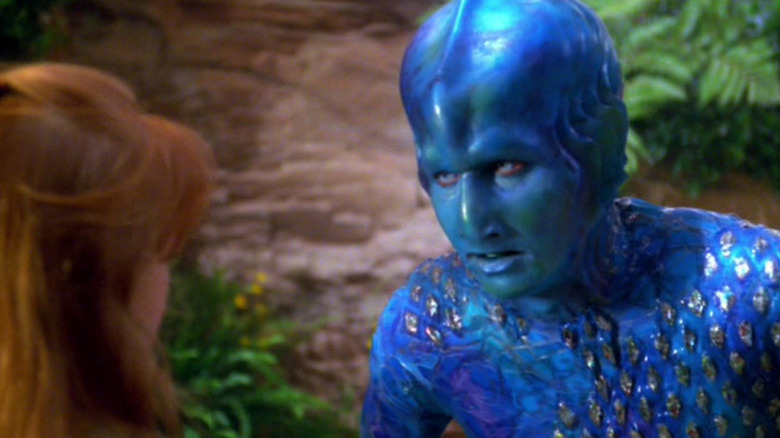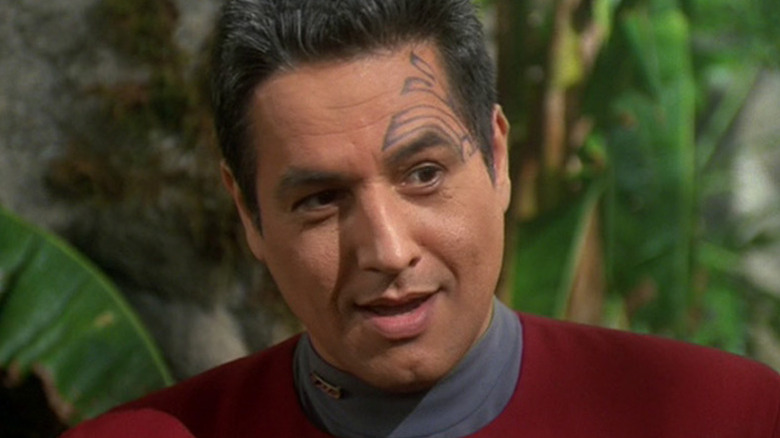The 5 Worst Episodes Of Star Trek: Voyager, Ranked
"Star Trek: Voyager" (1995-2001) was the fifth "Star Trek" series, and the third to be set in the 23rd century. It arrived when the franchise was on a prolonged hot streak, having just concluded a successful seven-season run of "Star Trek: The Next Generation," released its seventh movie in "Star Trek: Generations," and continuing with its ambitious series "Star Trek: Deep Space Nine." What's more, "Star Trek: Voyager" was the series that launched the UPN, a Paramount-owned TV network that was, at the time, full of promise.
"Voyager," however, proved to be slightly less popular than its 1990 counterparts. It struggled to tell interesting stories, and ratings were always just north of bad. The first three seasons of the series were not well-received, and audiences didn't start tuning in until the introduction of Seven of Nine (Jeri Ryan) in season 4.
The premise was tantalizing: The U.S.S. Voyager is magically whisked clear across the galaxy by a dying, all-powerful god alien who was looking for a potential mate. When the god alien dies, the Voyager is left stranded 70 years from Earth in a part of the galaxy that has never heard of the Federation. The crew of the Voyager would have to rely on their wits and their principles to survive, knowing there was no backup coming. Would they ever make it home? How would they even refuel? The ship's captain, Kathryn Janeway (Kate Mulgrew), had to become both resolute and more than a little authoritarian to keep her ship in shape. Sadly, the notion of the ship operating on limited resources was not addressed enough.
But within that premise came a lot of "spinning your wheels" episodes that didn't have interesting notions, or were just based on bad ideas. There were dumb character moments, and too many stories about the Borg and the holodeck. Below are the five worst episode of the series.
5. Tsunkatse
In "Tsunkatse" (February 9, 2000), Seven of Nine and Tuvok (Tim Russ) are abducted while on a survey mission, and held prisoner by a slimeball character named Penk (Jeffrey Combs). Tuvok is injured during the abduction, and Penk says he'll deny the Vulcan medical attention unless Seven competes in a local mixed martial arts competition called the Tsunkatse. Because she is a prisoner, Seven can't contact the Voyager for help. Imagine Chakotay's surprise when he attends the MMA fight and sees Seven as a competitor, fighting potentially to the death. Her central opponent is an outsize supra-fighter played by Dwayne Johnson, back when he was still being credited as The Rock.
There's noting inherently wrong with the story for "Tsunkatse," really. A sci-fi tale about an underground alien fighting ring is exciting enough, as it was already seen in the underrated 1989 action classic "Arena". ("Arena," incidentally, featured Marc Alaimo and Armin Shimerman from "Deep Space Nine.")
The problem with "Tsunkatse" is that it's not a good fit for "Star Trek." The premise is the stuff of schlocky action films, and way too much of the episode is devoted to fighting. Also, "Star Trek" did stories like this already with mixed success (see: "The Gamesters of Triskelion" or "Code of Honor"). "Tsunkatse," more than those, feels like it's pandering to WWE fans. Plus, it focused too heavily on Seven's fighting abilities, when Tuvok, the Voyager's security officer, would have been a more appropriate protagonist. The "Voyager" writers loved Seven, however, so many, many episodes revolved around her, even when they didn't need to.
4. Spirit Folk
Early in "Voyager," in order to provide the series with some visual variety, we see a commonly visited holodeck locale called Chez Sandríne, a recreation of a quaint French pub back on Earth. When ratings began to flag, the showrunners turned Chez Sandríne into a tropical bikini beach full of half-naked models. Then, when that didn't work, the bikini beach was turned into the least interesting thing yet: a quaint 19th century Irish village called Fair Haven. There is nothing remotely interesting about Fair Haven, and it seems to have been introduced as a favor to the actors more than a favor to audiences.
In "Spirit Folk" (February 23, 2000), it's revealed that the NPC holographic characters in Fair Haven are slowly gaining rudimentary consciousnesses, and notice when the Voyager crewmates do things like delete or rewrite the program in front of them (something NPCs aren't supposed to notice). They begin to call the Starfleet officers Spirit Folk, assuming they are trickster deities hellbent on destruction. They will take Tom Paris (Robert Duncan McNeill) and Harry Kim (Garrett Wang) hostage. The episode will climax when one of the holograms, a handsome bartender named Michael (Fintan McKeown), uses a mobile emitter to exit the holodeck, telling Captain Janeway — smitten with him — that he is a hologram.
Perhaps I'm heartless, but it's hard to care about the fates of the holograms or concern myself with their programming drifts. The Doctor (Robert Picardo) is a hologram who gained sentience, of course, and Janeway has to be wary when she accidentally creates new consciousnesses, but it would be easy to delete Fair Haven altogether. I have no attachment to the fate of a fake village video game that the Voyager characters play.
3. The Fight
Chakotay (Robert Beltran) was conceived with diversity in mind. Chakotay was a First Nations character, the first main character on a "Star Trek" series with that distinction. He was to bring an element of spirituality to the series, which was also rare on the ordinarily empirical "Star Trek." All of these are fine ideas. Problems arose with the character, however, when the "Voyager" producers hired Jamake Highwater, an author who claimed to be Cherokee, but who was actually Jackie Marks, a man born in Los Angeles and descended from Eastern European Jews. A look back over his bibliography revealed that Marks had claimed multiple backstories. Marks was trusted to introduce authentic First Nations practices into "Voyager," but was actually making stuff up as he went along.
So whenever Chakotay went on a "vision quest" on "Voyager," it had to be taken with a grain of salt. These episodes were written by non-Native writers who didn't know any better, and confirmed by a fake Cherokee man committing fraud.
Add to that the fact that "The Fight" (March 24, 1999) is also an incredibly boring episode. It involves the Voyager entering a sector of Chaotic Space, an eerie area that seems to be giving Chakotay hallucinations. Chakotay imagines himself in a boxing ring with an alien, sparring and getting lessons from his elders. His hallucinations are connected with a vision quest he had been attempting earlier in the episode, trying to communicate with psychic aliens ... or something. It's not very memorable.
"The Fight" is unclear and haphazardly written, and doesn't offer any particularly deep insight into Chakotay. It's just a festival of boxing hallucinations that are interesting to look at. Chakotay had such potential, and it was never properly plied.
2. Once Upon a Time
Man, oh, man, is this one annoying.
Early in "Voyager," a character named Samantha Wildman (Nancy Hower) gave birth to a daughter named Naomi. By the show's fifth season, Naomi was a little girl played by actress Scarlett Pomers, and she had become friends with Seven and with Neelix (Ethan Phillips), the show's jolly hobbit. "Once Upon a Time" (November 11, 1998) sees Samantha injured while on an away mission, and there is a very real possibility that she might die before she can be rescued. Rather than tell her that her mother is in danger, Neelix takes the young Naomi to the holodeck where they enact a whimsical children's book called "The Adventures of Flotter." Flotter T. Water (Wallace Langham) is a brightly colored elemental who lives in a forest.
"Once Upon a Time" is bad for several reasons. For one, Neelix proves that he is a terrible morale officer and even worse with children, unable to talk to a kid about hard topics. Neelix isn't good at a lot, and his presence on the ship is often called into question by Trekkies. Secondly, Naomi, as the daughter of a Starfleet officer, would likely have been told that her mom's job was dangerous, and that risky situations like this might arise. Thirdly, and most importantly, "The Adventures of Flotter" is a staggeringly uncreative conceit. I understand that the story is meant to be frivolous, and only descends into chaos when Naomi gets upset (a handy metaphor), but it hurt my skull whenever Flotter's name is mentioned. Even for a fake children's story, "The Adventures of Flotter" sucks.
1. Tattoo
Just like with "The Fight," "Tattoo" (November 6, 1995) explores Chakotay's past, and his connection to his tribe's heritage. Sadly, we now know it's kind of B.S., tainting "Tattoo" and making it seem false and culturally insensitive. The episode is also boring, told mostly thorough flashbacks and infused with bumper sticker wisdom.
While on a distant planet, Chakotay and Tuvok discover a pattern on the ground that closely resembles the tattoo that Chakotay sports on his temple. A mystery is afoot. It will eventually be revealed that the native inhabitants of this distant world traveled to Earth many centuries earlier and visited Chakotay's tribe, gifting them the symbol and other pieces of alien wisdom. The aliens assumed that Chakotay's tribe had been wiped out, and Chakotay gets to explain that, yes, Native Americans were once grievously maltreated, but that humans eventually outgrew their genocidal ways. It's a simple, corny story, but it is at least in the spirit of "Star Trek" (despite it playing fast and loose with the First Nations diaspora).
The above story is intercut with interminable flashback scenes of the teenage Chakotay (Douglas Spain) bickering with his father (Henry Darrow) about the role of tradition in the 24th century. Teen Chakotay is a whiner, but will be taught a lesson while on a camping trip.
According to screenwriter Michael Piller, who once talked about "Tattoo" with Cinemafantastique Magazine, his script was written in a hurry to prove that "Voyager" can be fast-paced. "Tattoo" is fast-paced, but its ideas aren't well-developed. Despite the high amount of incident, the story is still dull, and the "wisdom" of Chakotay's tribe are a clumsy amalgam of Native beliefs that have very little basis in reality. "Tattoo" is bad, irresponsible, and not interesting.
